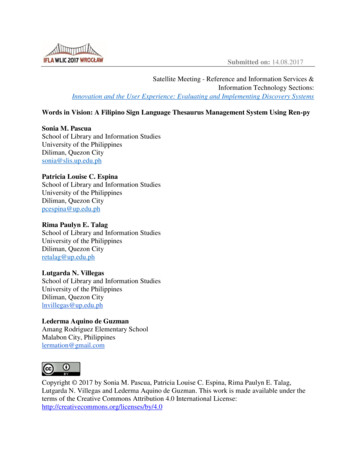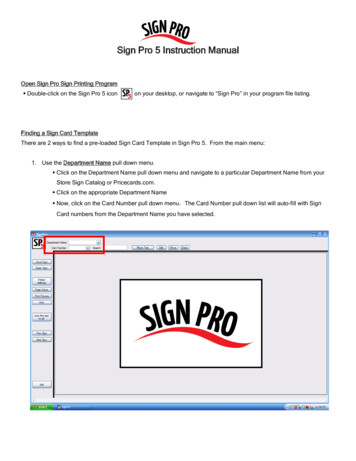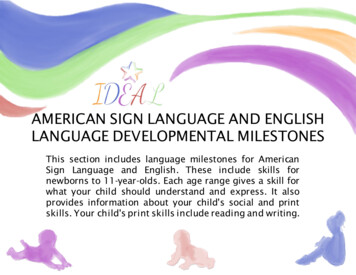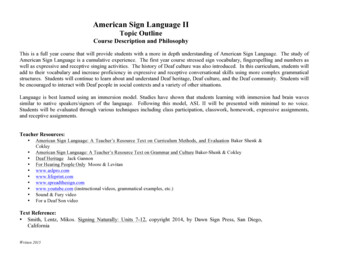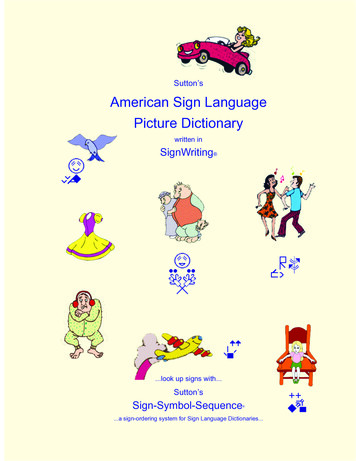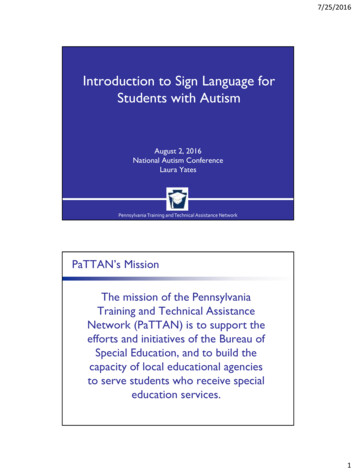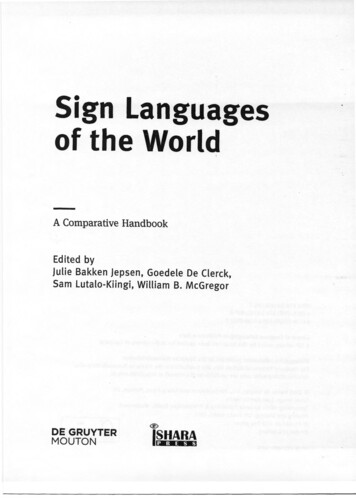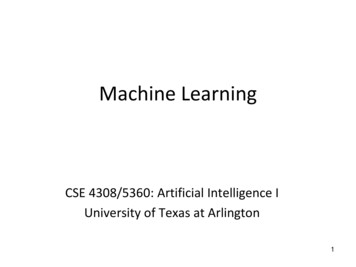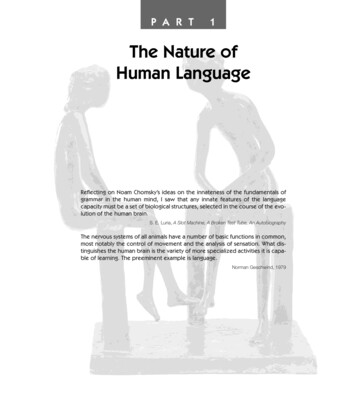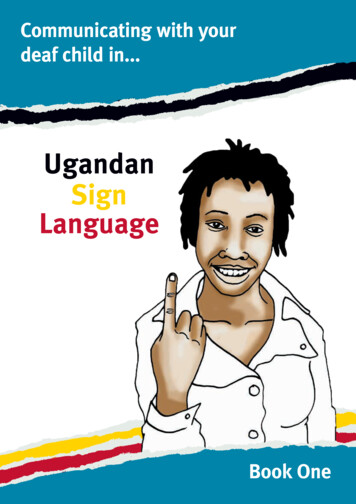
Transcription
Communicating with yourdeaf child in.UgandanSignLanguageBook One1
stnetnoC356472ContentsIntroductionChaptersNotes
6 Chapter 1Greetings and Courtesy10 Chapter 2Friends and Family13 Chapter 3Fingerspelling and Numbers16 Chapter 4Going Shopping24 Chapter 5The World and Far Away31 Chapter 6Children’s Rights36 Chapter 7Health42 Chapter 8Express Yourself3
4
IntroductionThis book is for parents, carers, guardians and families with a basic knowledge of UgandanSign Language (USL) who want to develop their USL skills to communicate at a moreadvanced level with their deaf children using simple phrases and sentences.This is the second edition of the book, first published in 2013 now with added amends andcontent following consultation with users.We want this book to: Empower families to improve their communication skills Ensure deaf children are included in their family life and in their communities Empower deaf children to express their own views and values and develop the socialskills they need to lead independent lives Allow deaf children to fulfil their potentialHow to use this bookSign language is a visual language using gesture, body movements and facial expressionsto communicate. This book has illustrated pictures to show you how to sign different words.The arrows show you the hand movements needed to make the sign correctly.This book is made up of eight chapters, each covering different topic areas.Each chapter has a section on useful vocabulary followed by activities to enable you topractise phrases using the words learned in the chapter. Each sign has the English meaningwritten below followed by a space to write your local language (LL) if necessary or to writethe signs in the way you would easily remember.Emphasis in sign language is only made through facial expressions and the nature of thehand movement. For example, to emphasise a certain issue, you will have to increase theweight of the facial expression and move your hands faster with a lot of energy or move itslowly based on the meaning you want to make. Sign language has its own structure andtherefore the revision sentences will follow the structure of sign language.This is your book, please take it home with you and keep on practising what you have learntto be good in USL. Remember, your deaf child and their siblings can offer a very interestingopportunity to practise and in some cases, they can also be your teacher at home.Thank youDeaf Child Worldwide would like to thank Nasser Ssenyondo, Robert Nkwangu, Eroku Simon,Aguti Esther, Bonie Busingye, Juliet Mirembe, Esther Nakiberu, Kepha Mecha Ombati,John Kizza and Richard Mativu Musau for their help with revision of this book.5
enOretpChaGreetings and CourtesyYouMeFriendHallo.Let’s be friends/You are my friendLocal language:Good Morning.Good Evening.Good Afternoon6.
PleaseThank youSorryWelcomeWait.Help meFineHow.SentencesYouWhoYouWhat is your name?How are you?Local language:Local language:How7
PleaseHelp meHelp me please.Local language:NowYouMeYourWhereYou and I are friends now.Local language:HomeWhere is your home?.Local language:8Friend
BookYourGive meGoodFriendYourWhoPleasePlease give me your book.Local language:YouYou and I are friends now.Local language:FriendWho is your friend?Local language:Activity 1Task 1: In pairs, practise greetings and introducing a friend to the group.Task 2: Role play. Your deaf child has come home with a friend.As a parent you are asking him / her about his / her new friend.Sign out your questions.9
owTretpCha10ParentsChildren.MotherFather.Friends and phewCousin.
Grand motherGrand fatherGrand daughter.FriendEnemy.Activity 1Tom’s FamilyThis is a picture of Tom’s family. Tom has a t-shirtlabelled ‘A’, as the instructor points at the differentpeople in Tom’s family, using USL, identify theother members.Activity 2This is a picture of Tom’s nuclearfamily and his extended family.The relatives are labelled with letters,using USL, identify each member inreference to Tom.11
Activity 3Sign out conversations based on the pictures.Activity 4Try describing in USL the following relatives of your deaf child: Aunt Cousin Grandmother Uncle12
eerhTertpaChFinger Spelling and NumbersOne Hand Manual AlphabetABCDEFGHIJKLMNOPQRSTUVWXYZ13
Numbers and Counting1263748100ElevenSixteenThousand14Million59
SentencesNameMineDINAMineJUMAMy name is Dina.Local language:NameMy name is Juma.Local language:Activity 1Using one-hand-manual-alphabet, spell your name.Activity 2In pairs, alternate in spelling different common words. Your partner will spell a randomword and you will tell them what they just spelled.Activity 3Practice different numbers, tell the year, birth date for your first born etc.15
eviFretpahCGoing ShoppingMarket.Weighing ScaleFruitVegetableOrangeTomato.16CassavaIrish PotatoSweet PotatoOnion.PumpkinBananaOmena/Silver FishRice.
Bread.MilkSugarSaltMeatTea Leaves.FlourPineappleList.17
Making pluralsYou can use numbers to make plurals in USL.OrangeElevenEleven oranges.Local language:WashTomatoSixWash six tomatoes and bring them to me.Local language:MilkBuy three packets of milk.Local language:18ThreeBuyGive Me
Activity 1Task 1: Practise making sentences in USL using numbers to make plurals.Task 2: Use the signs below to help you make more sentences.KiloCupHalfHow MuchSentencesBuySugarKiloSixHow MuchOneBuy one kilo of suger.Local language:MilkHow much does six packets of milk cost?Local language:BalanceAsk HimCheckAsk and check if you have the correct change.Local language:19
Activity 2Sign out how you would send your deaf child to the shop to buy the following items:1. 2kg of sugar, 2 packets of milk, 1 cabbage and 5 tomatoes with 15,000 shillings.2. 1 loaf of bread and 2 oranges.3. Rice, salt, tea leaves and sweet potatoes.Being specificFlourPoshoPosho FlourLocal language:FlourChapatiChapati FlourLocal language:FlourPorridge flourLocal language:20Porridge
People at the MarketWorkMarketWhoLocal language:MechanicBarberThe MechanicThe BarberLocal language:Local language:Activity 3Use the picture below to make sentences about sending your child to different peopleworking at the market.21
Important VerbsBuyTakeCountBring MeLook.RunAsk HimShowAsk MeTell.22ChooseSearch.
SentencesMarketRunVegetableBring MeRun to the market and bring back dodo.Local language:MeatHalfKiloBuyBalanceBring MeBuy half a kilogram of meat and bring back the change.Local language:Activity 4Practise making sentences based on the two examples above.Key Points to Remember When signing instructions to your child, use short pauses to separate the differenttasks you want them to carry out. People working at the market may not know USL. Ask your child to write down theshopping list as you sign it to them. (This is a good way to check that they haveunderstood you.) Your child can use the written list to communicate with peopleat the market. This can be helpful in rural areas where shops are often dark, itemson display are difficult to see and it is not easy for a deaf child to point to the thingsthey want to buy.23
eviFretpahCThe World Aroundand Far urHouseLandGate.Land Lord.
SentencesHomeMARUCleanMaru’s home is clean.Local language:HouseThreeThereThere are three houses there.Local language:LandNearHouseMaizeGatePassGrowThe garden near the house has maize.Local language:CowImpossibleThe cow cannot pass through the gateLocal language:25
Activity 1Use the picture at the beginning of the chapter to sign as many sentences as possibleabout Maru’s home.Important Places to KnowHospital.Bank.26Police .
SentencesRiverHomeNearThe home is near the river.Local es are grown in the big land.Local language:AreaThisZeroThere is no hospital in this area.Local language:SchoolWhereWhere is the school.Local language:27
Important Point to Remember Using sketches to explain directions can help your deaf child understand how to getto places they have not been to before.Towns in bbeLiraMasaka.
SentencesBushenyiThereTeaMuchBigKampalaThereSugar CaneA lot of tea grows in Bushenyi.Local language:UgandaCityKampala is the capital city of Uganda.Local language:MukonoDistrictSugar cane grows in Mukono districtGrow.Local language:AruaEntebbeFarDriveHourEightArua is far from Entebbe, it is about eight hours drive.Local language:29
Activity 2Use the different modes of transport below to sign sentences about travellingto different eTrain.Activity 3Task 1: Sign out simple sentences about different regions in Uganda and thecommon activities there.Task 2: Pick a place name card. Sign the name of the place on your card and someinformation about the area – for example, how to get there, how much taxifare would be needed, what the town is famous for.30
xiSretpChaChildChildren’s RightsRightsChildren’s rights.Local language:ExampleGoodGood Examples.Local language:31
Useful SignsHospitalPlaySafeCare.AdviceSickReport.Rights ViolationsExampleBad Examples.Local language:32Bad
Signs That May Help You to Explain Sexual e.Important Points to RememberDeaf children need to be taught:Give UpLove. The difference between good touching and bad touching. How to report any bad touching and not to keep secrets. How to yell or make noise if they experience a sexual attack. Not to accept gifts in return for sex.SentencesSchoolGoodGoAlwaysIt is always good to go to school.Local language:33
NightWalkGoodNothingIt is not good to walk at night.Local language:ChooseFriendGoodChoose good friends.Local language:Trust MeTell MeIfProblemTrust me and tell me if you have any problems.Local language:Activity 1In groups, sign out conversations based on the following scenarios:12Child labour.A child denied an education.A child at risk of sexual abuse.A well protected child, well advised and aware of his / her rights.34Key Points to Remember Deaf children need to be able to describe people to report abuse. Teach your child to give sign names to relatives and other people in the village they are regularly in contact with. As a parent, you need to know these signs names. Teach your child how to describe people using characteristics like tall, short, fat, thin.34
3533
eToes.
Hair.Head.Nose.Teeth.Elbow.Hand.Leg.37
Good HealthHealthGoodGood Health.Local language:BodyCareWellEatWellLook after your body by eating well.Local language:Important VerbsWash HandsWash UtensilsWash FaceWash ClothesWash Fruit.SweepCleanMopShave HeadCut Nails.38
Activity 1Sign out what happens after this picture.Sign out what happens after this picture and where each person goes.39
Diseases and SymptomsMalariaCold or FluMumpsCholeraAIDS.CoughHeadacheStomach AcheToothacheVomiting.Diarrhoea.Activity 2Play this game in pairs. One person touches a part of their body and the other personsigns a sentence about that body part.40
Activity 3Sign sentences about the following scenarios.What has the child not done?What should the child do?Activity 4Use each of the following signs to make a sentence, give instructions, or ask a question:Wash HandsMake BedWash ClothesShave HeadClean.Key Point to Remember The expression on your face shows your child whether you are instructing them to dosomething, asking a question, or simply telling them something.41
thgiEretpahCExpress YourselfHow Are You Feeling?YouHow are you feeling?Local language:42FeelHow
Useful Activity 1Sign out how the people are feeling in the pictures below.43
Activity 2Use facial expressions to show the following feelings and emotions: Happy smile Sneer Anger Inquisitive Disappointment Hilarious laughter Surprise SadnessSentencesYouSadWhyFeelHowTiredWorkWhy do you look sad?Local language:YouLet me know how you feel.Local language:MeI am tired because I am always working.Local language:44Always
Useful SignsTo show the degree or intensity of how you feel, you may have to use the sign two orthree times, or use the signs for ‘more’ or ‘much’.MeHappyYouExamNowHappyPassI am happy because you passed your exam.Local language:YouPlayYou are happy because you have been playing.Local language:MeSadI am feeling sad.Local language:45
Activity 2Sign out sentences using different signs two or three times to emphasise a feeling oremotion. Also practise sentences using the signs for ‘more’,‘much’ and ‘many.’MuchMoreMany.Activity 3Play this game in pairs. One person uses facial expressions to show different feelings andemotions and the other person signs out the meaning of the facial expression.Activity 4Use the following signs to make sentences:ShockMissLaughDead.46
Notes47
This book is for parents, carers, guardians and families with a basic knowledge of Ugandan Sign Language (USL) who want to develop their USL skills to communicate at a more advanced level with their deaf children using simple phrases and sentences. This is the second edition of the book
